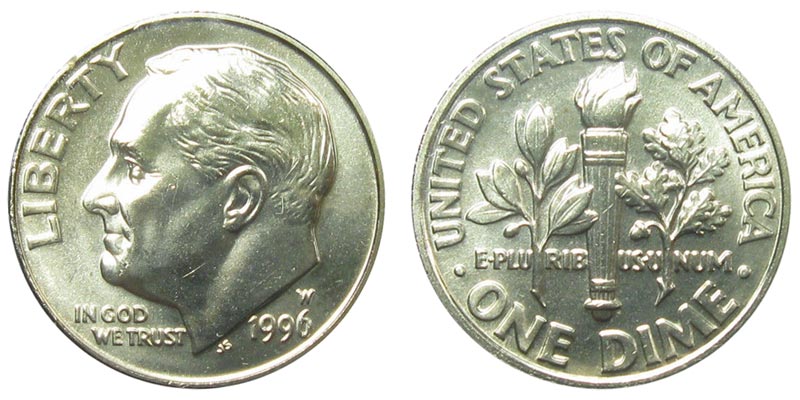What Are Dimes Made Of?
The United States dime is made from 91.67% copper and 8.33% nickel.
Can you spare time to learn about the dime? If so, you’re going to find out some pretty neat stuff about this denomination, including what it’s made from and how it’s made.
Dimes may not see as much use as they once did – back when it cost only a dime to place a call on a payphone. Even if payphones and phone booths have been relegated to the archival files of history, the dime remains with us today as an integral part of the United States monetary system.

Roosevelt dimes were first introduced by the U.S. Mint in 1946 with a 90% silver composition.
Once Upon a Disme: What Dimes Used to Be Made From
The Coinage Act of 1792, which established the United States Mint, spelled out the various kinds of coinage the new mint was to strike for the young United States. Among the many denominations was a coin known as the disme, which was the earliest form of the dime when it was first struck in 1792. The word “disme” has French origins and means “tenth.”
Before long, the disme had transformed into the “dime” and was in regular production by 1794. The early dimes were struck from a composition of 89.24% silver and 10.76% copper. This continued until 1837, when the fineness was modified to 90% silver and 10% copper. The composition remained untouched until the mid-1960s.
What’s the Dime Made from Today?
By 1963, rising silver prices and a pervasive coin shortage exacerbated by millions removing dimes (and other coins) from circulation due to their increasingly valuable silver content led the U.S. government to mull alternatives. Things only got worse as the nation’s silver supplies shrank and the need for more coinage grew.
In the spring of 1965, the writing was on the wall; keeping 90% silver compositions in the coin’s circulating coinage was clearly unsustainable. Something had to be done – and soon!
After Congressional debate on the pressing matter, including input from President Lyndon B. Johnson, a decision was made. It was determined that the most feasible solution was for the United States to debase its coinage. President Johnson signed the Coinage Act of 1965 into law on July 23 of that year, authorizing the removal of silver from dimes in lieu of a new copper-nickel clad composition; a similar move was made with the quarter, while the half-dollar saw a reduction in silver fineness from 90% to 40%, with eventual elimination of the precious metal altogether in 1971.
However, beginning in 1992 the U.S. Mint resumed using a silver composition for some numismatic dimes, mostly in proof format. When the silver dime resumed in 1992, it boasted a 90% silver fineness parallel with the traditional composition in use for well more than a century. Beginning in 2019, all silver dimes were promoted to a .999-fine silver alloy, more in keeping with the virtually pure finenesses of other silver coinage struck for collectors and investors today.
Still, all circulating United States dimes struck since 1965 have been made with the copper-nickel clad composition of 91.67% copper and 8.33% nickel.
How Are Dimes Made?
Dimes are struck in multi-stage process similar to how other United States coins are struck today. Dimes begin their lives as long sheets of metal, which are cut into little dime-sized discs at the U.S. Mint in a process known as blanking. These blanks are then heated in a furnace in a step known as annealing, which softens the metal and makes the coins more suitable for striking. This part of the coin-making process is particularly important for copper-nickel coins like dimes, as nickel is a very hard metal – one that can be tough on dies and other striking equipment.
Once the dime blanks are annealed, they are washed and dried, then they are fed into an upsetting device, which raises a little lip of metal around the perimeter of the disc in preparation for striking of the rim. At this stage in the game, blanks become planchets when their edges are upset, or raised.
From there, the dime planchets move on to be struck by the dies, which produce the designs onto the obverse and reverse. While the dies are doing their thing, a retaining collar corrals the dime planchet, keeping the coin centered and in place while being struck and simultaneously creating the coin’s edge reeding.
Afterward, the newly minted dimes are inspected to ensure their quality and appearance are on point (the U.S. Mint doesn’t like creating errors, even if collectors love them). Once the dimes have passed their inspection, they are counted and bagged before being shipped off to the Federal Reserve for dispersal into circulation.
Check out our article that explains how coins are made in the minting process step-by-step!
Joshua McMorrow-Hernandez is a journalist, editor, and blogger who has won multiple awards from the Numismatic Literary Guild. He has also authored numerous books, including works profiling the history of the United States Mint and United States coinage.
Read more about United States coins from numismatic experts:
More from the Gainesville Coins Blog about coin collecting:
Collector Resources for Understanding the Hobby of Collecting Coins
What Is an Uncirculated Coin? Guide to Condition and Value
What Is a Brilliant Uncirculated Coin? Beginner's Guide
What Is a Proof Coin? Overview for Coin Collectors
What Is a Gem Coin? Understanding Quality, Rarity, and Value
